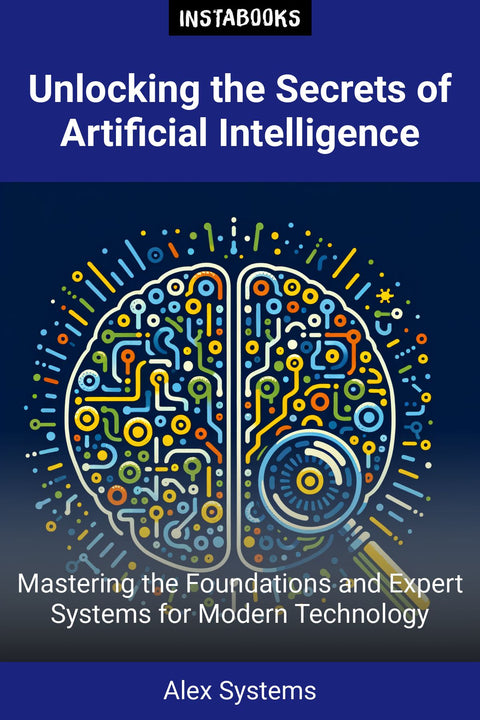
Unlocking the Secrets of Artificial Intelligence
Mastering the Foundations and Expert Systems for Modern Technology
Included:
✓ 200+ Page AI-Generated Book
✓ ePub eBook File — read on Kindle & Apple Books
✓ PDF Print File (Easy Printing)
✓ Word DOCX File (Easy Editing)
✓ Hi-Res Print-Ready Book Cover (No Logo Watermark)
✓ Full Commercial Use Rights — keep 100% of royalties
✓ Publish under your own Author Name
✓ Sell on Amazon KDP, IngramSpark, Lulu, Blurb & Gumroad to millions of readers worldwide
AI Book Preview
Below you'll find a comprehensive preview of all chapters in this book. Each section provides a glimpse into the key concepts, practical insights, and valuable knowledge you'll gain.
Chapter 1: The Basics of Artificial Intelligence
Introduction to AI
Artificial Intelligence (AI) is the cornerstone of modern technology, enabling machines to mimic human intelligence and solve complex problems. This section introduces the fundamental concepts of AI, its historical evolution, and its transformative impact across industries.
History of AI
The history of Artificial Intelligence traces its evolution from early theoretical foundations in the 1950s to the groundbreaking advancements that shaped modern AI systems. Readers will explore key milestones, influential pioneers, and the technological breakthroughs that transformed AI from a speculative concept into a driving force of innovation.
Current Applications
Artificial Intelligence is already transforming industries through applications like natural language processing, autonomous vehicles, and predictive analytics. Readers will explore how these technologies are being implemented in real-world scenarios, driving innovation and efficiency across diverse fields.
Chapter 2: Search and Problem Solving
Search Algorithms
Search algorithms are the backbone of problem-solving in AI, enabling systems to navigate complex spaces and find optimal solutions efficiently. This section explores fundamental techniques like breadth-first search, depth-first search, and heuristic-based methods, equipping readers to apply these strategies in real-world scenarios.
Game Playing Strategies
Game playing strategies in AI reveal how algorithms like minimax and alpha-beta pruning enable machines to make optimal decisions in competitive environments. Readers will explore how these techniques balance exploration and exploitation to simulate human-like reasoning in games such as chess and Go.
Problem Solving Techniques
Effective problem-solving in AI relies on structured techniques such as heuristic search, constraint satisfaction, and optimization algorithms to navigate complex decision spaces and find optimal solutions. Readers will explore how these methods are applied to real-world challenges, enhancing their ability to design intelligent systems that solve intricate problems efficiently.
Chapter 3: Logic and Knowledge Representation
Propositional Logic
Propositional logic serves as the fundamental building block for understanding complex reasoning in AI, enabling the representation of statements and their relationships through logical connectives. Readers will explore how to construct and evaluate truth tables, analyze logical arguments, and apply these principles to real-world AI systems.
Predicate Logic
Predicate logic extends propositional logic by introducing quantifiers and variables, enabling the representation of complex relationships and reasoning about objects and their properties. Readers will explore how predicate logic forms the backbone of formal knowledge representation, essential for building intelligent systems and solving real-world problems.
Knowledge Representation Methods
Knowledge representation methods are essential for structuring information in AI systems, enabling machines to reason and make decisions effectively. This section explores key techniques such as semantic networks, frames, and ontologies, providing insights into how AI models capture and utilize knowledge.
Chapter 4: Advanced AI Techniques
Non-Monotonic Reasoning
Non-monotonic reasoning explores how AI systems can handle incomplete or uncertain information by revising conclusions as new evidence emerges. Discover how default logic, circumscription, and defeasible reasoning enable machines to mimic human-like adaptability in complex decision-making scenarios.
Uncertainty in AI
Uncertainty in AI explores how systems handle incomplete or ambiguous data through probabilistic reasoning, Bayesian networks, and decision-making under unpredictability. Readers will uncover methods to enhance AI robustness and reliability in real-world, imperfect environments.
Heuristic Search
Heuristic search techniques empower AI systems to efficiently navigate complex problem spaces by leveraging informed strategies to prioritize promising paths. Readers will explore key algorithms like A* and best-first search, understanding how they optimize decision-making in real-world applications.
Chapter 5: Robotics and AI
AI in Robotics
AI is revolutionizing robotics by enabling machines to perceive, learn, and act autonomously in complex environments. Readers will explore how AI algorithms empower robots to perform tasks ranging from precise industrial automation to adaptive decision-making in dynamic settings.
Sensor Integration
Sensor integration is the cornerstone of enabling robots and AI systems to perceive and interact with their environment effectively. Readers will explore the principles, technologies, and challenges of combining diverse sensors to enhance real-time decision-making and autonomy in intelligent systems.
Control Systems
Control systems are the backbone of robotics and AI, enabling precise decision-making and automated responses in dynamic environments. This section explores the principles, architectures, and real-world applications of control systems, empowering readers to design intelligent systems that adapt and perform complex tasks autonomously.
Chapter 6: Natural Language Processing
Understanding Human Language
Understanding human language is a cornerstone of Natural Language Processing, enabling machines to interpret, generate, and interact with text and speech meaningfully. This section explores the complexities of linguistic structures, semantics, and context to bridge the gap between human communication and AI comprehension.
Text Analysis
Text analysis unlocks the power of extracting meaningful insights from unstructured data by leveraging techniques like tokenization, sentiment analysis, and topic modeling. Readers will discover how to transform raw text into actionable information, enabling smarter decision-making in applications ranging from customer feedback analysis to content recommendation systems.
Language Generation
Language generation explores how AI systems create coherent, contextually relevant text, from simple sentence construction to complex storytelling and dialogue. Readers will uncover the techniques behind models like GPT and learn how they are transforming industries such as content creation, customer service, and personalized communication.
Chapter 7: Computer Vision
Image Recognition
Image recognition, a cornerstone of computer vision, enables machines to interpret and classify visual data with remarkable accuracy. Readers will explore the fundamental algorithms, neural network architectures, and real-world applications that power this transformative technology.
Video Analysis
Video analysis leverages computer vision techniques to extract meaningful insights from dynamic visual data, enabling applications like motion tracking, activity recognition, and real-time surveillance. Readers will explore the algorithms and methodologies used to process and interpret video streams, bridging the gap between static image analysis and temporal understanding.
Visual Data Interpretation
Visual data interpretation unlocks the ability to extract meaningful insights from images and videos, transforming raw visual inputs into actionable knowledge. Readers will explore techniques like feature extraction, object detection, and scene understanding, essential for building intelligent systems that perceive and analyze the visual world.
Chapter 8: Expert Systems
Introduction to Expert Systems
Expert systems are AI-driven programs designed to emulate human decision-making by leveraging specialized knowledge and rule-based reasoning. This section explores their architecture, functionality, and real-world applications, offering a foundational understanding of how they solve complex problems across various industries.
Knowledge Base and Inference Engine
The knowledge base and inference engine form the core of expert systems, where structured data and logical reasoning combine to emulate human decision-making. Readers will explore how these components interact to solve complex problems and drive intelligent applications across industries.
Knowledge Engineering
Knowledge engineering is the cornerstone of building effective expert systems, involving the systematic acquisition, organization, and representation of domain-specific knowledge. Readers will explore the methodologies and tools used to transform human expertise into actionable, rule-based systems that drive intelligent decision-making.
Chapter 9: AI Programming Languages
Introduction to LISP
LISP, one of the oldest and most influential programming languages in AI, provides a powerful framework for symbolic computation and problem-solving. Readers will explore its foundational syntax, unique features, and enduring relevance in modern AI development.
Introduction to PROLOG
PROLOG, a declarative programming language rooted in logic, empowers developers to build intelligent systems by focusing on problem-solving rather than procedural steps. Readers will explore its syntax, core principles, and applications in AI, gaining insights into how PROLOG excels in symbolic reasoning and expert system design.
AI Development Tools
Discover the essential tools and frameworks that streamline AI development, from popular libraries like TensorFlow and PyTorch to integrated platforms for model training and deployment. Learn how to leverage these tools to build, optimize, and scale AI applications efficiently.
Chapter 10: Real-World Applications
Case Study: Manufacturing
Artificial Intelligence is revolutionizing manufacturing by optimizing production processes, reducing downtime, and enhancing quality control through predictive maintenance and intelligent automation systems. This case study explores how AI-driven solutions are transforming the industry, offering actionable insights for professionals aiming to implement these technologies effectively.
Case Study: Healthcare
AI-driven healthcare systems are revolutionizing patient care by enabling precise diagnostics, personalized treatment plans, and efficient resource management. This case study explores how expert systems are transforming medical decision-making and improving outcomes in real-world healthcare scenarios.
Case Study: Finance
Artificial Intelligence is revolutionizing finance by optimizing trading strategies, risk management, and fraud detection through advanced expert systems. This case study explores how AI-driven models are transforming decision-making processes and enhancing efficiency in the financial industry.
Chapter 11: The Future of AI
Emerging Trends
Emerging trends in AI, such as generative models, edge computing, and AI-driven sustainability solutions, are reshaping industries and creating new possibilities for innovation. Readers will explore how these advancements are driving the evolution of intelligent systems and transforming the future of technology.
Ethical Considerations
Ethical considerations in AI demand a careful balance between innovation and responsibility, addressing issues like bias, privacy, and accountability. Readers will explore frameworks and strategies to ensure AI systems are developed and deployed in ways that align with societal values and ethical principles.
AI in Society
AI’s transformative impact on society is reshaping industries, governance, and daily life, raising critical questions about ethics, equity, and human-AI collaboration. Readers will explore how AI integrates into social systems, its potential to address global challenges, and the responsibilities it demands from developers and policymakers.
Chapter 12: Getting Started with AI
Resources for Learning
Discover essential resources, from online courses to research papers, that will accelerate your journey into AI mastery and expert systems. Explore curated tools and platforms to deepen your understanding and stay ahead in this rapidly evolving field.
Building an AI Project
Building an AI project requires a structured approach, from defining objectives and selecting algorithms to training models and evaluating performance. Readers will learn practical steps to transform theoretical AI concepts into functional, real-world applications.
Next Steps
Mastering AI requires actionable strategies to implement and scale intelligent systems effectively, focusing on real-world problem-solving and iterative improvement. Discover how to navigate challenges, leverage cutting-edge tools, and integrate AI solutions into diverse industries for transformative impact.
Target Audience
This book is written for students, professionals, and enthusiasts who want to gain a comprehensive understanding of Artificial Intelligence and Expert Systems, from foundational concepts to advanced applications.
Key Takeaways
- Understand the fundamental concepts and history of Artificial Intelligence
- Explore advanced techniques like non-monotonic reasoning and heuristic search
- Learn about the applications of AI in robotics, natural language processing, and computer vision
- Gain insights into expert systems and knowledge engineering
- Discover real-world case studies and future trends in AI
